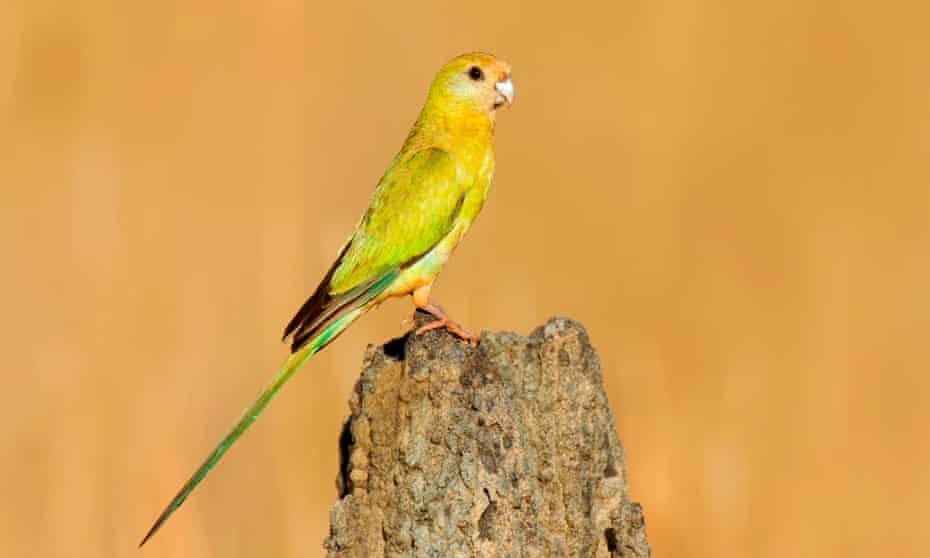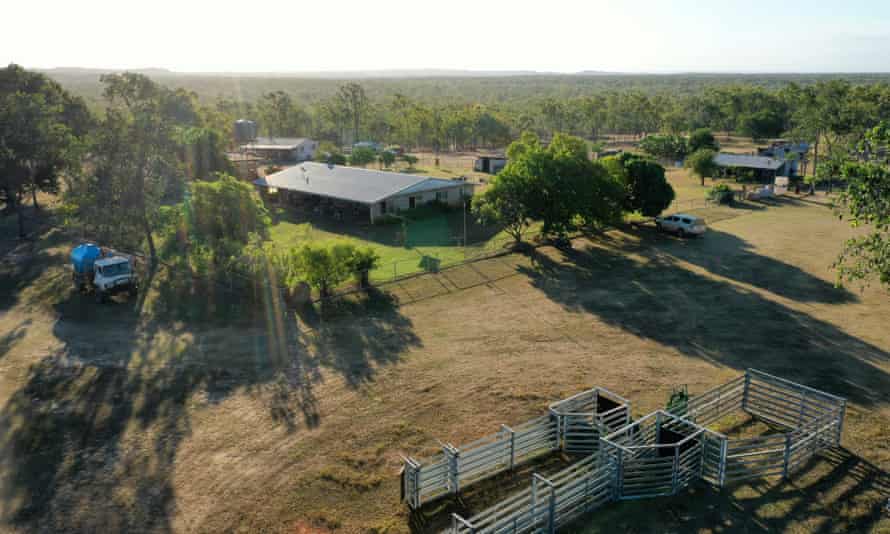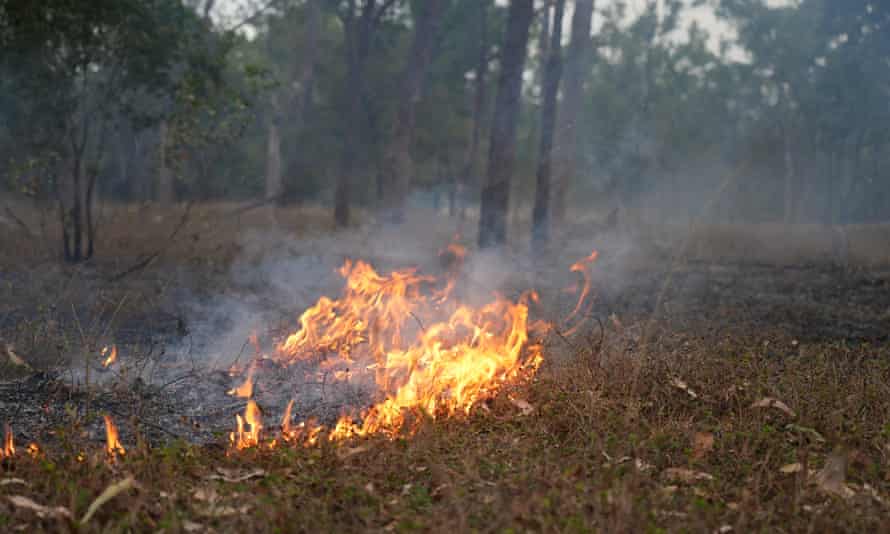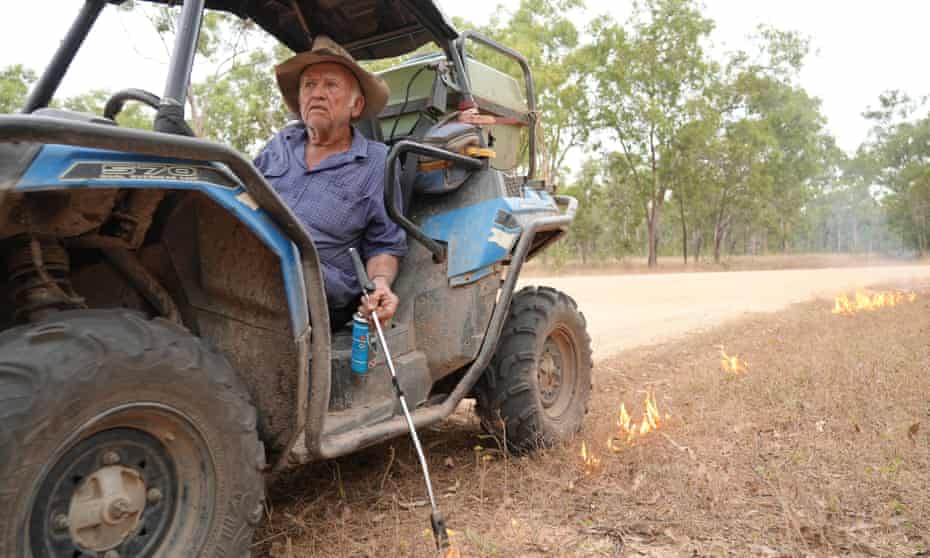‘We are going to lose these birds’: the quiet fight to save the golden-shouldered parrot

Nearly a century after the extinction of the paradise parrot, a tiny team is trying to protect its cousin – by using land clearing
In 1922, Cyril Jerrard captured the first and only photographs of the paradise parrot, the only Australian bird to be officially declared extinct since European colonisation. Jerrard was well aware he was looking at one of the last of its kind: “The one undisguisable fact [is] that the advent of the white man has spelled destruction to one of the loveliest of the native birds of this country,” he wrote in 1924.
The last accepted sighting of a paradise parrot – also by Jerrard – was in 1927, near Gayndah in the Burnett River district of southern Queensland.
Nearly a century later, in the fading light of dusk, I’m standing 20 metres from a bird feeder, clicking away in vain as a pair of golden-shouldered parrots, the paradise parrot’s closest surviving relative, accept a handout at Artemis Station, a cattle property on the Cape York Peninsula in the state’s far north. My images are rubbish, but while I’m watching, I have an eerie sense of how Jerrard might have felt.

Almost exactly 10 years ago, I watched a flock of 50 golden-shouldered parrots beside the Cape Developmental Road at Windmill Creek, near the northern boundary of Artemis. For decades, the 125,000ha station has been the species’ stronghold. Today it holds maybe 50 birds in total. There are scattered groups on neighbouring stations, and an unknown number in the remote Staaten River National Park to the south.
Once, golden-shouldered parrots were common from Coen, 120km north of Artemis, to Normanton in the Gulf of Carpentaria, where the first specimen was collected in the 1850s. They were trapped for aviculture (in the 1970s, a pair could fetch $10,000 on the black market; their value has decreased as the birds are common in captivity). Over decades, their range has shrunk, as a combination of pressures took their toll.
Now station owners Sue and Tom Shephard, in collaboration with a team led by applied ecologist Steve Murphy, are taking radical, counter-intuitive action to save the species. Using a mixture of brush-cutting and herbicide, the aim is to declutter the landscape to the parrot’s benefit. It took nearly two years to gain the relevant approvals from the state Department of Environment and Heritage Protection.
The project is a jointly funded venture between the federal government’s Landcare and Threatened Species Recovery Hub programs, and the Queensland government. Donations from the public are also being actively solicited. “People feel very invested in golden-shouldered parrots,” Murphy says. “A lot of people have been to Artemis. They know the station, they’ve met Tom and Sue.”

Land clearance is one of the most politically vexatious issues in Queensland. Yet that’s what’s happening here.
“We are clearing native vegetation, and the last thing the department wanted was a roughshod approach to giving their approval, which could have had all sorts of unforeseen consequences elsewhere,” Murphy says. The paperwork, finally signed off in late June, is an inch thick.
Once, the savannah country of Cape York consisted of open grasslands, studded with tall, mature eucalypts and the conical, witch’s hat-like termite mounds in which golden-shouldered parrots excavated their nests. Grazing and altered burning practices have transformed their habitat, which is now choked by an understorey of tea-trees and other low shrubs, as well as introduced grasses.
“It’s a long history of grass suppression through grazing – and I’m not having a go at farmers here – combined with low-intensity fire,” Murphy explains. “The very thing that keeps these plants in check in a normal grassland is intermittent high-intensity fire, early in the wet season. Without the grass layer to allow that higher-intensity fire, we’ve lost the very thing that’s kept all these plants in check.”

In the old country, the parrots had clear sightlines that helped them avoid predators. Small aerial birds called woodswallows would circle overhead, sounding the alarm at the first sign of danger. But the infestation of the landscape saw the woodswallows move on, and the parrots – having lost their early warning sentinels – were ambushed by hawks, butcherbirds, goannas and cats hiding in the scrub.
Stephen Garnett, professor of conservation and sustainable livelihoods at Charles Darwin University and co-author of The Action Plan for Australian Birds, identified the problem in the early 1990s. “The Shephards have held the situation around Artemis by providing supplementary food. But all around there, areas that I found [the parrots] commonly in the 1990s are now empty of nests,” he says. He estimates the total population at around 900 birds.
First, the birds’ range began to contract from the north-east. The situation is little better south of Artemis, at Mary Valley. “When there are parrots in an area, they do a test scratch on a lot of mounds, and you can see the bits of dirt that they scratch out. We did not find any evidence of any recent breeding,” Murphy says.
“The termite mounds just sit there like gravestones. You feel like you’re walking through a cemetery.”
There are three types of termite mounds on Artemis, made by different species: magnetic, bulbous and conical. For reasons not fully understood, golden-shouldered parrots are fussy, nesting almost exclusively in conical mounds early in the dry season. They are almost never reused: after being bored into by the parrots, it’s thought the termites reseal and reinforce hollows more solidly, making them harder to burrow into.

Now, Murphy’s team is staging an intervention, getting to work with a circular saw. Standing close to a mound where five chicks had just fledged, the team’s first objective is to clear the immediate area around the nests. “What we’re trying to do is reduce predator density across the landscape, and provide the maximum amount of visual distance for the parrots to see predators coming,” Murphy says.
Timber and debris piles up on the ground. While the threat of aerial ambush predation is being reduced, in the short term, there’s more cover for cats. “We’ll put a fire through later in the year and remove most of this, and anything that’s left we’ll physically drag away,” he says. “We’ve got to be constantly vigilant about the impacts we’re having, and make sure we don’t have any perverse outcomes.”
There’s a chirruping call behind us, and Murphy cocks his head and grins. “Parrots,” he murmurs.
For now, they should be relatively safe. The breeding season is over, and the birds have stopped visiting the mounds. These have their own complex ecology: a species of moth lives exclusively in the nesting hollows and is entirely dependent on the parrot for its existence: the moth’s larvae eat the parrot’s faeces in the nest chamber, performing a hygiene role for the chicks (the moth’s specific name is scatophaga: literally dung-eater).
Artemis has been owned by the Shephard family since 1911. Sue and Tom have borne witness to the changes in the landscape, particularly since the property was fully fenced. The fence helped with mustering, but confining the cattle put pressure on the impoverished, sandy soils.
“I can see we’re at fault, just as much as everyone else,” Sue admits. “But you’ve got to make money, prices go up and down, and when they’re down it’s really hard.”
She is being harsh blaming herself. Other than perhaps the traditional owners, the Thaypan and Olkola people of Cape York, who are assisting with re-establishing old burning practices, she knows as much about the parrots as anyone. For decades, she has helped lead banding programs to track individual birds’ movements. The parrots are also a tourist attraction, and the station charges a nominal ($10) camping fee.
In the old days, the Shephards had to see off poachers, who would set up traps for the birds at Windmill Creek. “We’d go to the races at Laura or somewhere and sometimes we’d come home early and find them,” Tom remembers. Once, he freed dozens of birds – not just parrots but finches and other species – from a mist net, which he then burnt, before confronting the trespasser. “I don’t think he liked me too much.”

If the grasslands can be restored, with appropriate fire management, the land should ultimately be better for both cattle and parrots. Murphy sees himself as an enabler. “The thing that makes this project unique at Artemis is that this is not an external, top-down, greenie conservation cause imposing itself on a grazing enterprise,” he says. “This is 100% coming from within.”
There is another driver. “The thing that motivates me a lot in this story is the paradise parrot, and it’s gone, we can’t get it back. This species is heading the same way.” Murphy puts himself in Cyril Jerrard’s shoes. “I often think, if I was transported back in time, what would you do? In some ways, I feel like a reverse time traveller. I’ve come back and I’ve gone, ‘Guys, if we don’t get in and solve this, we are going to lose these birds’.”